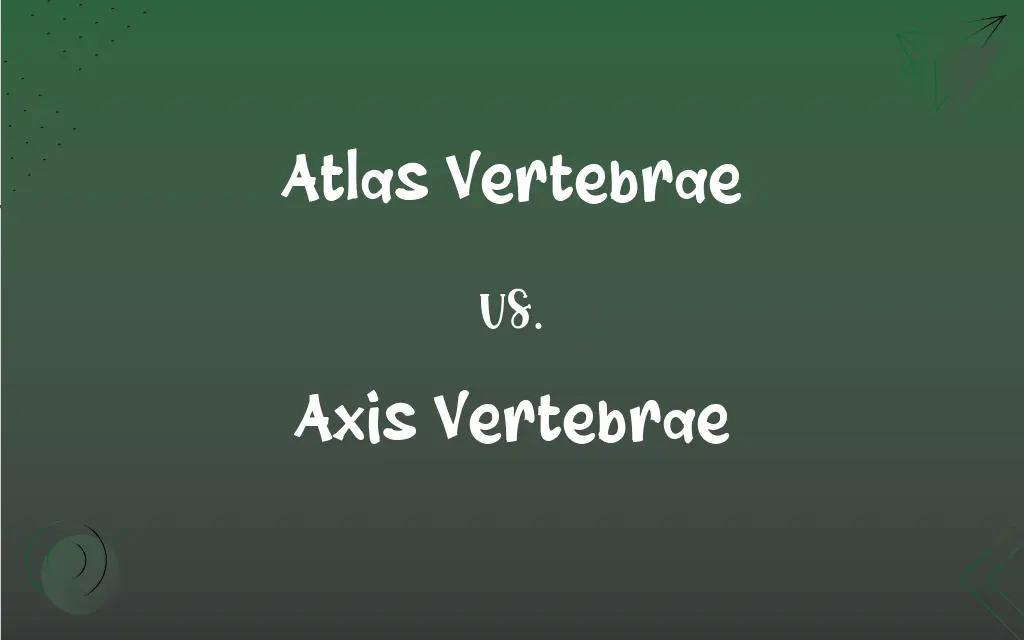Atlas Vertebrae vs. Axis Vertebrae: What's the Difference?
Edited by Janet White || By Harlon Moss || Updated on October 26, 2023
Atlas vertebrae support the skull; axis vertebrae enable head rotation. Both are cervical vertebrae in the spine.

Key Differences
Atlas vertebrae and axis vertebrae are the first and second cervical vertebrae, respectively, crucial for head movement.
The atlas vertebrae support the skull and enable nodding movements. Axis vertebrae, with their unique odontoid process, facilitate rotational head movements.
Structurally, atlas vertebrae lack a body and spinous process, whereas axis vertebrae have a distinctive odontoid process known as the dens.
The articulation between atlas vertebrae and the skull allows up-and-down movements, while the atlas-axis joint provides rotational capability.
Both atlas vertebrae and axis vertebrae are integral to the cervical spine, each contributing uniquely to head mobility and stability.
ADVERTISEMENT
Comparison Chart
Position in Spine
First cervical vertebra
Second cervical vertebra
Structural Feature
Lacks body and spinous process
Has odontoid process (dens)
Movement Enabled
Nodding (yes motion)
Rotation (no motion)
Articulation
With occipital bone of the skull
With atlas vertebra
Role in Spine
Supports the skull
Enables pivot for rotation
ADVERTISEMENT
Atlas Vertebrae and Axis Vertebrae Definitions
Atlas Vertebrae
First cervical vertebra.
The atlas vertebrae connect the spine to the skull.
Axis Vertebrae
Second cervical vertebra.
The axis vertebrae sit below the atlas in the spine.
Atlas Vertebrae
Allows nodding movement.
Nodding yes involves the atlas vertebrae.
Axis Vertebrae
Integral to cervical spine mobility.
The axis vertebrae contribute to the neck's flexibility.
Atlas Vertebrae
Articulates with the occipital bone.
The atlas vertebrae and the skull's occipital bone form a joint.
Axis Vertebrae
Forms a pivot joint.
The axis vertebrae form a pivot joint with the atlas.
Atlas Vertebrae
Lacks body and spinous process.
The unique structure of the atlas vertebrae allows head nodding.
Axis Vertebrae
Has odontoid process (dens).
The dens of the axis vertebrae is crucial for rotation.
Atlas Vertebrae
Supports the skull.
The atlas vertebrae bear the weight of the head.
Axis Vertebrae
Enables head rotation.
Rotating the head side to side involves the axis vertebrae.
FAQs
How do atlas vertebrae support the head?
They articulate with the skull to bear its weight.
What is the axis vertebrae?
It's the second cervical vertebra enabling head rotation.
What movement does the axis vertebrae facilitate?
It allows rotational movement of the head.
Do atlas vertebrae have a body?
No, they uniquely lack a body and spinous process.
What is the atlas vertebrae?
It's the first cervical vertebra supporting the skull.
What is the odontoid process on the axis vertebrae?
It's a projection that acts as a pivot for rotation.
How do atlas vertebrae differ structurally from other vertebrae?
They lack the typical vertebral body and spinous process.
Can atlas vertebrae move independently?
No, their movement is interdependent with the skull and axis.
Is the dens on the axis vertebrae crucial for neck movement?
Yes, it's essential for rotational neck mobility.
Is the axis vertebrae directly connected to the skull?
No, it connects with the atlas, which then connects to the skull.
What's unique about the structure of axis vertebrae?
They have the distinctive odontoid process (dens).
Do atlas vertebrae allow side-to-side head movement?
No, that movement primarily involves the axis vertebrae.
Are atlas vertebrae larger than axis vertebrae?
No, their size is relatively similar but their shapes differ.
Are axis vertebrae injuries common?
They are less common but can be serious.
Are atlas and axis vertebrae part of the cervical spine?
Yes, they are the first two vertebrae of the cervical spine.
Can disorders affect atlas and axis vertebrae?
Yes, conditions like arthritis or trauma can affect them.
Do both atlas and axis vertebrae have spinous processes?
Only the axis has a spinous process; the atlas does not.
Can damage to the atlas and axis vertebrae affect spinal stability?
Yes, it can significantly impact the stability and mobility of the spine.
Can atlas vertebrae injuries affect head mobility?
Yes, they can significantly impact head movements.
How do atlas and axis vertebrae work together?
They form a joint that allows complex head movements.
About Author
Written by
Harlon MossHarlon is a seasoned quality moderator and accomplished content writer for Difference Wiki. An alumnus of the prestigious University of California, he earned his degree in Computer Science. Leveraging his academic background, Harlon brings a meticulous and informed perspective to his work, ensuring content accuracy and excellence.
Edited by
Janet WhiteJanet White has been an esteemed writer and blogger for Difference Wiki. Holding a Master's degree in Science and Medical Journalism from the prestigious Boston University, she has consistently demonstrated her expertise and passion for her field. When she's not immersed in her work, Janet relishes her time exercising, delving into a good book, and cherishing moments with friends and family.
































































